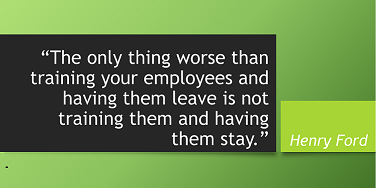Organizations are looking to fill the upper management positions that lead to the executive level to groom the leaders of tomorrow.
What are they looking for?
They are primarily looking for two characteristics in the people in their organization. The problem for those who wish to advance to the higher-paying higher responsibility positions in the organization is not in possessing these two characteristics, but in demonstrating them, in other words, letting senior management know that you possess them.
Over the past eight or 10 years in my travels and conversations with senior-level people in companies around the world, a common issue has been voiced. There seems to be a lack of senior mid-level managers in the organizations. This layer of top mid-level management is important to organizations because that layer is where the executives of the future will be drawn from, and where the CEOs of the organization will arise.
Related Article: Six Things You Can Do Today to Prepare for Leadership Tomorrow
What the executives pointed out is that that particular hierarchical level seems to be populated by employees who have reached that level based on seniority, and do not have the characteristics necessary to rise to the executive level. Many of these companies are forced to go outside the organization for their executive-level talent.
That the executives are looking for candidates with “excellent communication skills” practically goes without saying because those not possessing the ability to communicate well would never be considered in the first place.
There are actually two other characteristics which are critical to rising in the corporation. And it turns out that these two characteristics are also key ingredients to success in business analysis.
What are these two essential characteristics?
I will not keep you in suspense. This isn’t a mystery novel where the two characteristics will be exposed in the last sentence. The two characteristics that executives are looking for in the people that they would like to see as executives of the next generation are problem-solving and decision-making.
The successful business executive can handle challenges,
make decisions, and solve problems at a remarkable clip.
– Zig Ziglar
In a recent survey of 3169 hiring managers by CareerBuilder, the number one skill listed as needed for advancement was problem-solving and decision-making (they combined the two into one skill). 50% of the responders listed it as a mandatory skill. This is ahead of oral and written communications, performance improvement, leadership, team building and technology expertise. The survey covered all industries. As an article on the survey says, “it is not surprising to see problem-solving skills at the top of the list. The ability to find a problem, analyze it, create potential solutions, pick a solution and implement the solution is part of everyday life in IT.” [1] (and, I might add, part of everyday life for a business analyst)
That is easy enough said. We simply need to be decisive problem-solvers. But there are two aspects to this. First, we need to make sure we understand what a problem-solver is and what it means to be decisive. Secondly, we need to know how to make sure those making the decisions about who joins them in the ranks of upper management see the fact that we are clearly decisive and able to solve problems.
The definition of problem-solver and the definition of decisiveness, or decision-maker, may surprise you. Normally people think of problem solvers as those who come up with the solution to a problem, and the way to prove that you’re a problem-solver is to quickly come up with a solution that will work.
Similarly, the measure of decisiveness or a good decision-maker is usually based on whether the decisions made are right or not. Someone who makes more right decisions is considered to be a good decision-maker.
Actually, both of these mindsets are not accurate. Upper-level management is looking for something different.
Leaders are problem solvers by talent and temperament, and by choice.
Harlan Cleveland
The Office of Personnel Management (OPM) in the United States is an agency that provides the guidelines for hiring, promoting, staffing, and assessing the employees of the United States Federal Government. The OPM has published definitions of the characteristics and skills necessary for high-level management positions in the US Federal Government. The OPM has defined five Executive Core Qualifications of leadership competencies and characteristics needed to be successful, serve customers, and build successful teams and coalitions both within and outside an organization. While three of the core qualifications are focused on leadership (leading change, leading people, building coalitions and communications), and one is on business acumen, the center of the core qualifications is one called “results-driven.”
The results-driven executive core qualification consists of six skills: accountability, customer service, entrepreneurship, technical credibility, and the two we are focused on here, decisiveness and problem-solving.
This is the way the Office of Personnel Management defines decisiveness: “makes well-informed, effective, and timely decisions, even when the data is limited or solutions produce unpleasant consequences; perceives the impact and implications of decisions”.
This is the way the office of personnel management defines problem solving: “identifies and analyzes problems; weighs relevance and accuracy of information; generates and evaluates alternative solutions; it makes recommendations”.
What does that mean?
Leadership is all about problem-solving
– Colin Powell
In terms of problem solving, note that the definition does not mention actually solving the problem. A problem-solver is one who make sure that the real problem is being solved, that appropriate investigation and analysis has been done of the problem, and multiple potential solutions are identified (not just one), and recommendations are made, not solutions.
Does that mean you are a problem-solver if you don’t actually solve the problem?
Yes, that is what it means. Here is a scenario that illustrates this.
You are in a meeting with your peers and your boss. Your boss brings up a problem facing the organization. The boss is looking for a solution. In a few seconds, someone across the table offers a fairly decent solution to the problem. Then another person at the end of the table provides a solution. Someone else on your side of the table voices an agreement with one of those solutions. After a short discussion on the merits of each potential solution, you speak. You ask questions of the boss about the problem. You ask questions of the others in the meeting to make sure that the right problem is being discussed. You engender a short discussion on the cause of the problem. Then you suggest several solutions which include those already voiced. You do not state that any particular one is the solution, but accompany the alternatives with the benefits and risks of each solution. You leave it up to the boss to decide on the solution and “solve” the problem. Which of the three speakers does the boss consider a problem-solver? Cognitive studies have shown that the boss will leave the meeting thinking that you are the premier problem-solver of the group even though you didn’t actually present the solution.
The first step of solving any problem is trying to understand it by creating a mental model.
– Luke Hohman, [2]
Interestingly, if there were no need for an immediate response in this scenario, suppose you were to instigate the conversation about problem definition and root causes and prompt a discussion of alternative solutions, then suggest that time is necessary to consider the situation before coming up with a solution. Even if you did not spend the time thinking about the problem and potential solutions, the boss would consider that you were an excellent problem-solver.
That “pause” between the request for a solution and the response with multiple alternatives gives the impression that processing time has been taken to generate a better potential solution. Cognitive studies have shown that the act of taking time before answering a question or, in this case, producing a solution, elevates the quality of the response in the mind of the person with the problem or the one asking the question.
In any case, the person who focuses on defining what the real problem is, asking questions about the problem and the conditions that cause the problem, analyzing for root causes, and offering more than one alternative solution, is the one who is perceived to be the problem-solver. Again, it sounds like the typical business analyst response to being given a business problem to grapple with.
Again and again, the impossible decision is solved
when we see that the problem is only a tough decision
waiting to be made.
— Dr. Robert Schuller
Turning our attention to decisiveness, notice that nowhere in the definition of decisiveness is there any mention of whether a decision is right or wrong. There is a simple reason for this. You can never know whether a decision is right or wrong until after the decision has been made and actions have been taken to implement the decision. Sometimes you don’t know whether a decision is right or wrong for years afterward. How can an evaluator determine whether someone is a good decision-maker, someone is decisive, based on whether their decisions are right or wrong?
What is important in the evaluation of decisiveness is seeing that the decision-maker has a consistent and considered process when making a decision.
Informed decision-making comes from a long tradition of guessing and then blaming others for inadequate results.
Scott Adams
A study was done about 10 years ago of executives of US corporations, with a focus on chief executive officers. I don’t know how the study was done, but the results indicated that the typical CEO of an organization (the person making millions a year for their ability to lead, which includes making decisions) made the right decision only 33% of the time. I thought that was an interesting bit of trivia, but then another study was done just recently which produced the same results: executives of organizations make the right decisions only 33% of the time.
So why are they paid the big bucks? Of course, it’s their overall leadership abilities and business acumen, and so forth. In terms of their decision-making, they consistently follow a decision-making process.
Does this mean that you could be considered as decisive, a top-notch decision-maker, even if your decisions were right a small percentage of the time?
Well, in a word, yes.
And we have a cognitive basis for that conclusion. Human beings tend to try to justify their decisions and make them right once the decisions are made. If you have ever had a conversation with someone, a friend, relationship, team member or fellow employee about a decision that was made, and the conversation was all about why it was a great decision and the right decision for the situation, then you have participated in trying to make that decision right. For a number of psychological reasons – ego, pride, cognitive equilibrium – we have the need to try to make our decisions right – after they have been made.
Don’t worry about making the right decision;
worry about making the decision right.
So the key factor in being perceived as a decision-maker is to have a process for making decisions: ask questions about the alternatives, analyze to make sure that you understand the problem underlying the decision that needs to be made, ask for advice and counsel from those who are familiar with the conditions of the decision, review the impact of each alternative on those affected by the decision, and make the decision in a timely manner (not so quickly that it is a knee-jerk reaction, and not so long that the decision is not effective, or taken out of your hands).
Decision-making and problem-solving: two skills which, when mastered, will lead to the executive suite. Both skills can be learned, and both skills can be improved with practice. The important and necessary ingredient in the improvement of each of these two skills is to be aware of your decision-making and problem-solving processes. If you kept a daily list of the problems you solved or the decisions you made (business, personal, social, etc.), that alone would raise your awareness of how you solve problems and make decisions, and that alone will improve the skills.
And the really neat thing is that the OPM definitions of problem-solving and decisiveness sound like the US Office of Personnel Management was describing the actions of a business analyst. As I’ve said before, the CEOs and business leaders of tomorrow will come from the ranks of today’s business analysts.
[1] http://itmanagersinbox.com/390/the-9-most-desired-skills-of-hiring-managers/
[2] The Journey of the Software Professional, Prentice-Hall, 1997





